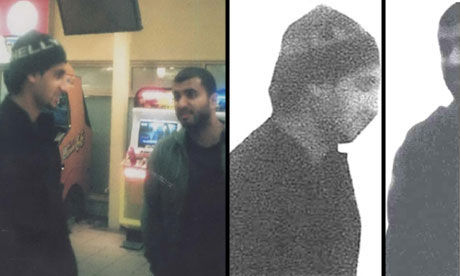
The inquests into the 52 victims of the attacks heard from a top MI5 officer that in April 2004 a photo that originally had Mohammad Sidique Khan and Shehzad Tanweer in it was shown to the informant Mohammed Junaid Babar, described as "one of the most significant sources the intelligence services had at that time". The pair were returning from meeting a known bomb plotter.
But instead of the original colour photograph, in which both men are clearly identifiable, an intelligence officer edited the photo to render Tanweer unrecognisable and crop out Khan altogether, and forwarded it to the US where Babar was in custody. The version was also converted to black and white. Babar had previously met Khan at a terrorist training camp in Pakistan but the photograph of Khan was not forwarded to the informant.
In uncharacteristically frank language, Hugo Keith, counsel to the inquests, told the MI5 officer: "I think one of my children could have done a better job of cropping out that photograph."
The edit, Keith said, had "left Tanweer without even identifying marks on his hat, much of a nose and parts of his clothing". The senior security services officer, giving evidence anonymously as "Witness G", said it was likely that the image had been edited to conceal the circumstances in which it was taken.
An agent had photographed the men at a service station on the M1, when the future bombers were returning home from a meeting with Omar Khyam, then under surveillance as the ringleader of the "Operation Crevice" fertiliser bomb plot.
Though no record of his motives existed, it was likely that the agent had wanted to get the image to Babar "as speedily as possible", said G. "America is not the other side of the moon," replied Keith. "The system must exist to allow colour photographs to be sent to America."
An inquiry in May 2009 by the Commons intelligence and security committee into the preventability of the attacks noted that the picture of Tanweer shown to Babar was of "poor quality". The image of Khan, inexplicably edited to remove more than half of his head and body, was probably deemed too poor even to forward, said G. The committee appears not to have been aware of the original, very clear, colour photograph of both men.
Earlier, the inquests heard that Khan's name, or cars or addresses associated with him, had been flagged in "seven or eight" intelligence incidents before the attacks, but the security services had not joined the dots to consider him an active threat.
But G rejected "any assertion that there were significant intelligence failings". In his statement to the inquests, Keith said, G had stressed MI5's "profound regret" that it failed to detect Khan's intentions and thus prevent the atrocities on 7 July 2005. "Every member of the service feels that," said G. The service had "no inkling of what was to befall London", and it would be "nonsensical and offensive" to suggest MI5 had failed to act to prevent an attack that they "supposed or hypothesised" was coming.
MI5 had seen a significant increase in resources and personnel since the bombings, G said. "I certainly think things have improved substantially since then."
The public, said Keith, would wish to know if the new system "could raise a red flag if there are a number of references to a name that is identical or similar".
"I think much depends on the name," said G. "There are plenty of Sidique Khans on our systems".
Keith said the intelligence linked to Khan dated back to January 2001, when he was filmed attending a camp in Cumbria run by known extremists. He was not identified as a participant until after 2005.
The inquests heard that in the course of the Crevice surveillance in 2003 to 2004, a Sidique Khan had received phone calls from key member of that plot, while West Yorkshire police found that a blue BMW that gave a lift to another known jihadist was registered to a Sidique Khan.
"Had the two pieces of information been put together it would at least have indicated a man, Sidique Khan ... having a link with two suspected extremists not otherwise connected," said Keith.
"It would have done if the information about the ... lift had been shared with us," said G. The inquests were also played a covert surveillance recording made in February 2004 in Khyam's car, which was not deemed significant at the time but later found, after repeated transcriptions, to reveal that Khan had been one of those discussing jihad.
G said the transcripts had not suggested any imminent plans to attack the UK, while the poor quality of the audio showed the difficult job faced by the security service, said Keith.



Comment: Smoke and Mirrors. When it comes to the London Bombings, the Facts Speak for Themselves